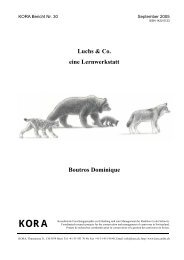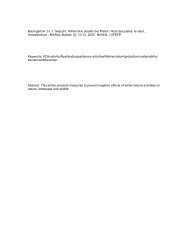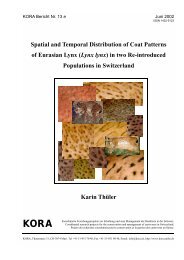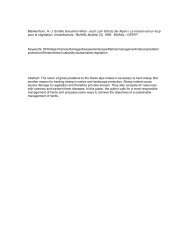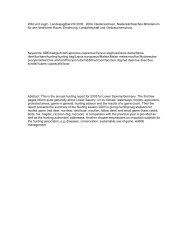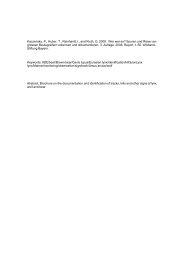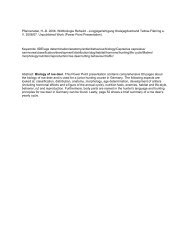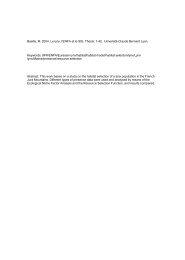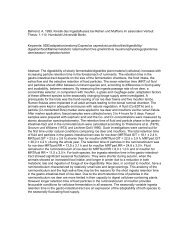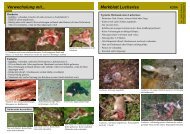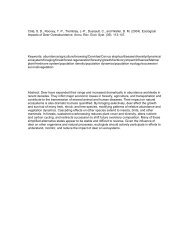Breitenmoser, U., Breitenmoser-Würsten, Ch., Capt, S ... - Kora
Breitenmoser, U., Breitenmoser-Würsten, Ch., Capt, S ... - Kora
Breitenmoser, U., Breitenmoser-Würsten, Ch., Capt, S ... - Kora
You also want an ePaper? Increase the reach of your titles
YUMPU automatically turns print PDFs into web optimized ePapers that Google loves.
<strong>Breitenmoser</strong>, U., <strong>Breitenmoser</strong>-Würsten, <strong>Ch</strong>., <strong>Capt</strong>, S., Molinari-Jobin, A., Molinari, P., &<br />
Zimmermann, F. (2007). Conservation of the lynx Lynx lynx in the Swiss Jura Mountains. Wildlife<br />
Biology 13, 340-355.<br />
Keywords: 8CH/8FR/conservation/habitat/history/Jura/lynx/Lynx lynx/poaching/prey/threats<br />
Abstract: Lynx Lynx lynx returned to a semi-natural, human dominated landscape in the Jura<br />
Mountains in France and Switzerland after reintroductions in the early 1970s. Controversy has<br />
resulted from lynx attacking sheep and preying on game species such as roe deer Capreolus<br />
capreolus and chamois Rupicapra rupicapra. We review the history of the lynx, the transition of<br />
the landscape and fauna in the Jura Mountains, and recent findings from long-term field studies<br />
on the species. Possible threats to the survival of the population are assessed. The ecological<br />
conditions for the existence of the lynx in the Jura Mountains have improved since the species<br />
was eradicated in the 19th century. Both habitat and prey base are suitable for maintaining the<br />
population. Immediate threats include traffic accidents and illegal killings. Long-term threats<br />
include small population size and genetic impoverishment as a result of the post-reintroduction<br />
bottleneck. We recommend conservation and management that involve local people and<br />
cooperation at national and international scales. Fragmentation of the habitat and the<br />
management system should be avoided, and landscape linkages from the Jura Mountains to<br />
adjacent mountain ranges should be established to promote a lynx metapopulation.
ORIGINAL ARTICLES<br />
Conservation of the lynx Lynx lynx in the Swiss Jura Mountains<br />
Urs <strong>Breitenmoser</strong>, <strong>Ch</strong>ristine <strong>Breitenmoser</strong>-Würsten, Simon <strong>Capt</strong>, Anja Molinari-Jobin, Paolo Molinari &<br />
Fridolin Zimmermann<br />
<strong>Breitenmoser</strong>, U., <strong>Breitenmoser</strong>-Würsten, C., <strong>Capt</strong>, S., Molinari-Jobin,<br />
A., Molinari, P. & Zimmermann, F. 2007: Conservation of the lynx Lynx<br />
lynx in the Swiss Jura Mountains. - Wildl. Biol. 13: 340-355.<br />
Lynx Lynx lynx returned to a semi-natural, human dominated landscape<br />
in the Jura Mountains in France and Switzerland after reintroductions in<br />
the early 1970s. Controversy has resulted from lynx attacking sheep and<br />
preying on game species such as roe deer Capreolus capreolus and chamois<br />
Rupicapra rupicapra. We review the history of the lynx, the transition of<br />
the landscape and fauna in the Jura Mountains, and recent findings from<br />
long-term field studies on the species. Possible threats to the survival of<br />
the population are assessed. The ecological conditions for the existence of<br />
the lynx in the Jura Mountains have improved since the species was<br />
eradicated in the 19th century. Both habitat and prey base are suitable<br />
for maintaining the population. Immediate threats include traffic accidents<br />
and illegal killings. Long-term threats include small population size<br />
and genetic impoverishment as a result of the post-reintroduction bottleneck.<br />
We recommend conservation and management that involve local<br />
people and cooperation at national and international scales. Fragmentation<br />
of the habitat and the management system should be avoided, and<br />
landscape linkages from the Jura Mountains to adjacent mountain ranges<br />
should be established to promote a lynx metapopulation.<br />
Key words: anthropogenic threats, conservation, history, Jura Mountains,<br />
Lynx lynx<br />
Urs <strong>Breitenmoser</strong>, Institute of Veterinary Virology, University of<br />
Berne, Länggass-Strasse 121, CH-3012 Bern, Switzerland - e-mail: urs.<br />
breitenmoser@ivv.unibe.ch<br />
<strong>Ch</strong>ristine <strong>Breitenmoser</strong>-Würsten, Simon <strong>Capt</strong>, Anja Molinari-Jobin, Paolo<br />
Molinari & Fridolin Zimmermann, KORA, Thunstrasse 31, CH-3074<br />
Muri b. Bern, Switzerland - e-mail addresses: ch.breitenmoser@kora.ch<br />
(<strong>Ch</strong>ristine <strong>Breitenmoser</strong>-Würsten); s.capt@unine.ch (Simon <strong>Capt</strong>);<br />
a.molinari@kora.ch (Anja Molinari-Jobin); p.molinari@kora.ch (Paolo<br />
Molinari); f.zimmermann@kora.ch (Fridolin Zimmermann)<br />
Corresponding author:Urs <strong>Breitenmoser</strong><br />
Received 12 August 2004, accepted 2 June 2006<br />
Associate Editor: Henrik Andrén<br />
340 E WILDLIFE BIOLOGY ? 13:4 (2007)
The preservation of large carnivores in humandominated<br />
landscapes will be one of the big challenges<br />
in nature conservation in the 21st century.<br />
On one hand, large carnivore populations need<br />
much space, usually considerably more than what<br />
protected areas offer, and must therefore be allowed<br />
to expand into landscapes used by humans,<br />
where, on the other hand, they are not always<br />
welcome. Suitable terrestrial carnivore habitat in<br />
the cultivated landscape is fragmented by widespread<br />
anthropogenic infrastructure. Predation<br />
on wild and domestic animals brings carnivores<br />
into direct conflict with human hunters and livestock<br />
breeders. Even where large carnivores enjoy<br />
legal protection, as in most European countries,<br />
traffic accidents and retaliation killings are often<br />
the two prominent causes of mortality (wolf Canis<br />
lupus: Boitani 2000; brown bear Ursus arctos:<br />
Swenson et al. 2000; Eurasian lynx Lynx lynx:<br />
<strong>Breitenmoser</strong> et al. 2000). Large carnivores act<br />
as umbrella or flagship species (Simberloff<br />
1998), and their presence (or the effort needed<br />
to maintain their presence) is an indicator not<br />
only of the quality of the environment (habitat<br />
and prey base), but also of human tolerance.<br />
The conservation of a large carnivore in a cultural<br />
landscape is complex, involving not only ecological<br />
knowledge, but also the understanding of<br />
human dimensions and the implementation of<br />
appropriate legislation, management and monitoring.<br />
The restoration and conservation of the Eurasian<br />
lynx in the Jura Mountains of Switzerland<br />
and France is a case study of returning a large<br />
predator to a modern cultivated landscape. The<br />
lynx was reintroduced into the Jura Mountains in<br />
the first half of the 1970s before expanding over<br />
the southwestern part of the mountain range<br />
(<strong>Breitenmoser</strong> & Baettig 1992, <strong>Breitenmoser</strong> et<br />
al. 1998, <strong>Capt</strong> 2007). The releases were done in<br />
secret, and there was no follow-up programme.<br />
The history of the scientific survey of the Jura<br />
lynx population started in the late 1980s. Retrospective<br />
collection of data in France and Switzerland<br />
began in 1986 (Herrenschmidt &Leger1987a,<br />
<strong>Breitenmoser</strong>&Baettig1992).Since then, monitoring<br />
systems have been established in both countries<br />
(Vandel & Stahl 1998b, Vandel 2001, <strong>Capt</strong> et al.<br />
1998), but comprehensive status reports were published<br />
only for the French part (Herrenschmidt &<br />
Leger 1987b, Vandel & Stahl 1998b, Stahl & Vandel<br />
1999). Radio-telemetry studies were conducted<br />
in the Swiss Jura Mountains during 1988-1998, and<br />
in the French part during 1995-1998, resulting in<br />
a number of theses and publications on lynx land<br />
tenure, demography, social organisation (Kaczensky<br />
1991, Dötterer 1992, <strong>Breitenmoser</strong> et al.<br />
1993), behaviour and habitat use (Bernhart 1990,<br />
Weigl 1993, Wölfl 1993, Wölfl & Wölfl 1996, Molinari<br />
& Jobin 2001, Zimmermann & <strong>Breitenmoser</strong><br />
2001), and predation on wildlife (Liberek 1992, Jobin<br />
et al. 2000, Molinari-Jobin et al. 2002) and livestock<br />
(<strong>Capt</strong> et al. 1993, Vandel & Stahl 1998a, Stahl<br />
et al. 2001a,b).<br />
A comprehensive review of ecology, population<br />
status and conservation needs of lynx in the Jura<br />
Mountains is lacking. In this paper, we compile<br />
results from monitoring and field studies including<br />
development and status of the population<br />
(<strong>Capt</strong> 2007), spatial behaviour (<strong>Breitenmoser</strong>-<br />
Würsten et al. 2007b), demography (<strong>Breitenmoser</strong>-Würsten<br />
et al. 2007a), predation aspects (Molinari-Jobin<br />
et al. 2007), and the suitability of the<br />
Jura Mountains as lynx habitat (Zimmermann &<br />
<strong>Breitenmoser</strong> 2007). These papers form the scientific<br />
framework for the 'technocratic' conservation<br />
of the lynx in the Jura Mountains. However, a 'holistic'<br />
conservation strategy considering the sociocultural,<br />
economic and political context implies<br />
more than ecological knowledge. In this first paper<br />
of the series, we provide some background<br />
information on the Jura Mountains and its ecological<br />
and cultural history and review the present<br />
knowledge under the aspect of potential threats<br />
and recommendations for a comprehensive conservation<br />
strategy. We regard the present status,<br />
not only of the lynx population, but also of its<br />
living space, the result of an evolving situation.<br />
Consequently, the assessment of the past and the<br />
present allows us to anticipate future challenges<br />
and opportunities. Hence, we ask the following<br />
questions:<br />
1) What are the contemporary ecological and anthropogenic<br />
conditions for the existence of the<br />
lynx in the Jura Mountains?<br />
2) How did these conditions change since the<br />
eradication of the lynx in the 18th and 19th<br />
centuries?<br />
3) What are the potential or identified threats to<br />
the population, the limits of human tolerance,<br />
and what are the apparent needs for its future<br />
conservation?<br />
E WILDLIFE BIOLOGY ? 13:4 (2007) 341
Figure 1. Jura Mountains in France and Switzerland. The shape of the range is indicated by the 500 m elevation isoclines. The centre of<br />
the field work was the Jura Mountains of the canton of Vaud (VD) and the neighbouring areas of the canton of Neuchâtel (NE) and the<br />
departments of Ain (01) and Jura (39). The study area in which radio-telemetry was performed is indicated by the two corners (position<br />
of the southwestern corner is 46u06'N/5u15'E and the position of the northeastern corner is 47u25'N/7u44'E). Labels and abbreviations<br />
of French departments and Swiss cantons are given in Table 1.<br />
Material and methods<br />
Study area<br />
The Jura Mountains stretch from the junction of<br />
the rivers Aare and Rhine in the northeast to the<br />
junction of the Guiers with the Rhone River in the<br />
southwest (Fig. 1). It is situated between the plateau<br />
of the Haute-Saône in France in the north<br />
and the Swiss Plateau in the south. The high ridges<br />
of this secondary mountain chain are 1,200-<br />
1,500 m a.s.l., the highest peak is the Crêt dela<br />
Neige at 1,718 m a.s.l. The rock is Mesozoic calcium<br />
from the ancient Tethys Sea. The formation of<br />
the parallel mountain chains of the Jura took place<br />
during the late phase of the formation of the Alps,<br />
in the late Tertiary period (Miocene to Pliocene, 13-<br />
5 million years BP). The result of the folding process<br />
was a mountainous karst landscape in the<br />
south, table mountains in the northeast, and high<br />
plateaus in the northwest (see Blant 2001 for details).<br />
Although the mountain chain, which is exposed<br />
to western winds from the Atlantic ocean,<br />
experience 1,300-2,000 mm precipitation annually<br />
(Blant 2001), water is scarce because the karst re-<br />
342 E WILDLIFE BIOLOGY ? 13:4 (2007)
gion supports surface waters only along valley bottoms.<br />
The Jura Mountains (Blant 2001) are more than<br />
what a traveller sees along the border between<br />
France and Switzerland. For lynx, we defined the<br />
outlines of the Jura Mountains according to geographic<br />
and habitat features, such as lakes and rivers<br />
as natural boundaries, or the sharp transition<br />
from the wooded slopes to the open agricultural<br />
plateau at the foothills in Switzerland. Where an<br />
absence of natural barriers occurs (i.e. in the northwestern<br />
periphery) we use the 500 m contour line<br />
(see Fig. 1) separating the mountain forests from<br />
the open agricultural landscape of the plains. Close<br />
to the foothills of the Jura Mountains, we find the<br />
large cities of Lyon, Geneva, Lausanne, Neuchâtel,<br />
Basel and Besançon. This area includes, completely<br />
or in part, 10 administrative units, three French<br />
departments and seven Swiss cantons (abbreviations<br />
are given in Table 1). The focus area for the<br />
field work summarised in this paper were the Jura<br />
Mountains in the canton of Vaud (VD), but dispersing<br />
lynx roamed over much of the mountains<br />
(see Fig. 1).<br />
Data sources and analyses<br />
Estimation of (relative) areas and population density<br />
for the administrative units (see Table 1) were<br />
determined with the Geographic Information System<br />
(GIS) Arc-View (ESRI, Redlands CA, USA),<br />
using CORINE land use data (European Topic<br />
Centre on Land Cover, Environment Satellite Data<br />
Centre, Kiruna, Sweden) for the entire Jura Mountains<br />
and GEOSTAT data (Federal Office of Statistics,<br />
data release 1992) for the Swiss part. As<br />
a consequence of differences in the resolution (250<br />
3 250 m grid for the CORINE, and 100 3 100 m<br />
for the GEOSTAT data), the geographic projection,<br />
and the classification of original categories,<br />
the results varied according to the data source. As<br />
a rule, we computed areas from vector rather than<br />
grid data and used the highest available resolution.<br />
Ecological and anthropogenic conditions for<br />
the existence of the lynx in the Jura<br />
Mountains<br />
Habitat elements<br />
The Jura Mountains stretch over 300 km from the<br />
southwest to the northeast, 30-60 km from the<br />
southeast to the northwest, and cover almost<br />
14,000 km 2 (see Fig. 1 and Table 1). Forest is the<br />
most prominent landscape feature of the Jura<br />
Mountains and a natural timberline is lacking. Half<br />
of the entire surface is covered by forest, and none<br />
of the 10 administrative units listed in Table 1 has<br />
, 40% woodland cover. Forest types range from<br />
mixed deciduous forest with relict Mediterranean<br />
elements on the foothills of the south slopes to the<br />
Table 1. <strong>Ch</strong>aracteristics of the cultivated landscape of the French departments and Swiss cantons comprising the Jura Mountains.<br />
Data sources are CORINE land use data (G 250 ) for France and the entire Jura Mountains, and GEOSTAT data (G 100 ) for Switzerland.<br />
Population density data are not available from the CORINE data set, but the population density (inhabitants/km 2 ) computed<br />
from the G 100 data set is highly correlated (r 2 5 0.949, P , 0.001) with the relative area of settlements from the G 250 for the Swiss<br />
cantons, and is a good indicator for the human presence.<br />
Unit Sign Language<br />
Relative (%) areaof<br />
-----------------------------------------------------------<br />
Area inside the Jura Population Settlements<br />
------------------------------<br />
-------------------------<br />
Km 2 a<br />
% of unit density G 250 Forest Pastures<br />
French departments 8923 65.2 - 2.4 - 50.6 27.8<br />
Ain 01 F 2483 43.0 - 4.0 - 59.8 13.0<br />
Jura 39 F 3068 60.4 - 1.7 - 54.6 20.7<br />
Doubs<br />
25 F 3372 64.5<br />
-<br />
1.9 - 41.3 37.5<br />
---------------------------------------------------------------------------------------------------------------------------------------------------------------------------------------------<br />
Swiss cantons 4768 34.8 188 4.1 5.9 45.4 12.6<br />
Vaud VD F 1054 33.0 60 0.9 3.2 49.4 14.0<br />
Neuchâtel NE F 690 100.0 b 213 3.4 5.6 44.0 16.5<br />
Jura JU F 765 92.7 80 1.5 3.9 44.2 15.9<br />
Berne BE F/G 679 11.3 199 3.5 5.6 48.4 17.6<br />
Solothurn SO G 615 78.6 237 5.6 7.7 47.5 9.9<br />
Basel-Landschaft BL G 518 100.0 491 13.3 12.2 42.0 5.8<br />
Aargau<br />
AG G<br />
447 23.4<br />
198 5.7 7.6 41.0 3.1<br />
---------------------------------------------------------------------------------------------------------------------------------------------------------------------------------------------<br />
Jura Mountains 13691 - 3.0 - 49.3 21.8<br />
a Due to the large grid size, the G 250 overestimates high and underestimates low values, but the relative ranking of the units is correct.<br />
b Only lake of Neuchâtel outside the Jura Mountains.<br />
E WILDLIFE BIOLOGY ? 13:4 (2007) 343<br />
G 100
oreal coniferous forest on the ridges and in the<br />
cold depressions on the mountain plateaus. <strong>Ch</strong>aracteristic<br />
tree species are oaks Quercus sp. at the<br />
climatically favourable bases of the hills, beech Fagus<br />
sylvatica and other deciduous trees on the<br />
slopes, and fir Abies alba on the ridges and the high<br />
plateaus. Spruce Picea abies was historically restricted<br />
to a few extreme sites, but is widespread<br />
and locally dominant today. Permanent pastures<br />
used for grazing cattle in summer cover 22% of<br />
the Jura Mountains (see Table 1). A harsh climate<br />
and infertile soils limit high elevation land use to<br />
forestry and pastoralism (Wachter 1995). All other<br />
arable land (e.g. crops, meadows, vineyards and<br />
orchards) make up from 10% (NE) to 25% (AG)<br />
of the administrative units, and settlements cover<br />
3% (range: 1.7-12.2%) of the mountain range (see<br />
Table 1).<br />
Wild prey<br />
The main prey of the lynx in the Jura Mountains is<br />
the roe deer Capreolus capreolus. Roe deer made up<br />
69% of all kills found, followed by the chamois<br />
Rupicapra rupicapra (22%), red fox Vulpes vulpes<br />
and brown hare Lepus europaeus (Jobin et al.<br />
2000, Molinari-Jobin et al. 2007). The roe deer is<br />
abundant throughout the Jura Mountains. <strong>Ch</strong>amois<br />
frequent the highest chain of the mountain range<br />
(mainly the Swiss part) and exhibits a clustered distribution<br />
(e.g. along the rocky slopes of ravines).<br />
Reliable and comparable estimates of the population<br />
densities are lacking for both species. Molinari-<br />
Jobin et al. (2002) have estimated a density of 6-9<br />
roe deer/km 2 and of 1-2 chamois/km 2 for the study<br />
area in the Jura VD. This is probably a medium to<br />
low density compared to other roe deer habitat<br />
of the mountain range, but an above-average density<br />
of chamois for the entire Jura Mountains.<br />
Although potential prey species are diverse (see review<br />
in Molinari-Jobin et al. 2007), other species are<br />
only occasionally killed and are not a significant<br />
part of the lynx diet. The abundance of the main<br />
prey does not appear to be limiting in the Jura Mountains.<br />
Depredation<br />
Domestic prey in the Jura Mountains were usually<br />
sheep Ovis aries (Vandel & Stahl 1998a, Angst et al.<br />
2000, Stahl et al. 2001a, Molinari-Jobin et al. 2007).<br />
Sheep are mainly available in the lower parts of the<br />
Jura Mountains along the northern rim, where they<br />
are kept in fenced parks. Most of the attacks occurred<br />
in the French department of Ain (01 in<br />
Fig. 1), fewer in the department of Jura (39), and<br />
considerably fewer in the Swiss part, primarily the<br />
canton of Jura (JU). In France, a total of 1,132<br />
attacks (with an average of 1.6 sheep killed or<br />
wounded in an attack) were recorded during<br />
1984-1998, with a peak of 188 attacks in 1989 (Stahl<br />
et al. 2001a). On the Swiss side, 153 sheep were<br />
identified as lynx kills during 1981-2001, with a peak<br />
of 43 in 2001 (KORA, unpubl. data). The higher<br />
parts of the Jura Mountains were not affected by<br />
lynx attacks on livestock. Sheep flocks are rare, and<br />
the pastures are predominantly used by cattle during<br />
summer. Although livestock is of no importance<br />
for the sustenance of the lynx population, the killing<br />
of sheep by lynx affects human tolerance (Molinari-<br />
Jobin et al. 2007), and has repeatedly led to legal<br />
removal of problem animals (Stahl et al. 2001b,<br />
Angst et al. 2002) and to illegal retaliation killings<br />
(Ceza et al. 2001).<br />
Human population, political and cultural units<br />
The percentage of built-up area is an indicator of<br />
human population density, which is considerably<br />
high. In Switzerland, it ranges from 60 inhabitants/km<br />
2 (Jura VD) up to 491 inhabitants/km 2<br />
(BL). Roughly extrapolated over the French part<br />
from the relative area of settlements (G 250 in Table<br />
1), the human density over the entire Jura<br />
Mountains is 130-140 inhabitants/km 2 . It is an important<br />
characteristic that is relevant to the conservation<br />
of the lynx because much of the natural landscape<br />
adjoins areas with high human population<br />
densities. Current pattern of human settlement in<br />
an otherwise remote and rural area reflects the early<br />
importance of local industry, first the small-scale<br />
production of lime, iron and glass, fuelled by charcoal,<br />
and later the watch and ancillary industry<br />
(Blant 2001, Bergier 1990).<br />
The Jura Mountains are easily identified on an<br />
aerial photo, but have never been a cultural or political<br />
unit. The international border separates the<br />
three French departments from the seven Swiss cantons<br />
(see Fig. 1). As a consequence of the centralistic<br />
French system, the three French administrative<br />
units have a similar political structure, but the Ain<br />
(01) department belongs to the region Rhône-<br />
Alpes, whereas the departments Jura (39) and<br />
Doubs (25) are part of the region Franche-Compté.<br />
Within both regions (and of course within France as<br />
a whole), the Jura Mountains are an economic<br />
fringe area. This is also true for the Swiss cantons<br />
344 E WILDLIFE BIOLOGY ? 13:4 (2007)
of Vaud, Bern and Aargau (VD, BE and AG in<br />
Fig. 1), where the Jura region is only a small part<br />
of the canton. The other four cantons lie entirely<br />
(NE, JU and BL) or mostly (SO) within the Jura<br />
Mountains. The lack of unity has not only political,<br />
but also cultural foundations: almost 90% of the<br />
Jura Mountains belong to the French-speaking area,<br />
but the most populated parts (the cantons of SO,<br />
BL and AG) belong to the German-speaking area<br />
(see Table 1).<br />
Hunting system and protected areas<br />
The hunting system in the French Jura Mountains<br />
is community-based; local residents hunt within<br />
the limits of their municipality, supervised by regional<br />
wildlife officers of the Office National de<br />
la <strong>Ch</strong>asse et de la Faune Sauvage (ONCFS). The<br />
French-speaking Swiss cantons of VD, NE, JU<br />
and BE use a licence hunting system (a hunter gets<br />
a limited quota of game for the entire area of the<br />
canton within a restricted period) controlled by<br />
state game wardens. The Germanic cantons of<br />
SO, BL and AG have a lease-based system with<br />
private hunting parties managing wildlife in an enclosed<br />
area.<br />
Blant (2001) presented an extensive overview on<br />
protected sites in the Jura Mountains. There are 41<br />
nature reserves with limited access, but they are all<br />
very small. Two regional parks exist, and two more<br />
have been designed. They are important for the<br />
maintenance of the regional biodiversity and provide<br />
good (protected) habitat and healthy prey populations<br />
for the lynx, but are open for regulated<br />
pastoralism, limited timber exploitation, hunting<br />
and recreation. Considering the huge space required<br />
by a viable lynx population, they are rather<br />
insignificant at the population level.<br />
History of the landscape and the large<br />
mammal fauna of the Jura Mountains<br />
The modern vegetation of the Jura Mountains developed<br />
at the end of the last ice age some<br />
12,000 years ago. Under the climatic influence of<br />
moisture from the Atlantic Ocean, forests became<br />
the dominant type of vegetation (the name 'Jura' is<br />
derived from the Celtic term for forest; Blant 2001.)<br />
This process was never free from human influence.<br />
Humans have exploited the Jura Mountains first as<br />
hunter-gatherers, then as nomadic herders and finally<br />
as sedentary and semi-nomadic farmers. The<br />
foothill oak forests have been used to produce charcoal<br />
for smelting, and water-powered industries<br />
have existed on the rivers in the narrow gorges since<br />
the Middle Ages.<br />
Early human activities promoted species diversity<br />
through the creation of new cultural habitats<br />
with plants and animals from open (not forested)<br />
ecosystems; the maximum diversity in Europe was<br />
probably reached around 1800 (Blant 2001). Regardless,<br />
human exploitation of the ecosystem<br />
started much earlier. The general pattern was that<br />
overexploitation of forests and silvopastoral livestock<br />
husbandry, along with unrestricted hunting,<br />
destroyed the habitat and the prey base of large<br />
carnivores. The predators, still present after the destruction<br />
of wild ungulate populations, were then<br />
forced to prey on livestock. This, in turn, boosted<br />
their persecution and extinction. There is no quantitative<br />
data available for the Jura Mountains, but<br />
local descriptions suggest that this pattern of nature<br />
destruction was the same elsewhere, although it<br />
happened some 100 years earlier than in the Alps<br />
(<strong>Breitenmoser</strong> 1998).<br />
Destruction of forest<br />
N.E. Tscharner, sheriff of the Lower Aargau (the<br />
Jura part of today’s canton of Aargau) reported in<br />
the year 1768 that the forests of his district could no<br />
longer satisfy local demands for timber and firewood<br />
(Wullschleger 1974). Tscharner identified<br />
several reasons for the destruction of the woods:<br />
lack of silvicultural knowledge, short rotations of<br />
logging, larceny as a result of general poverty, and<br />
the neglect to protect tree regeneration from cattle<br />
(silvopastoralism was usual). Other reasons for<br />
heavy 18th and 19th century logging were the increasing<br />
need for firewood and charcoal (Rieben<br />
1957), the floating of logs from the Jura Mountains<br />
to the shipyards at the mouth of the Rhone river,<br />
and the need of the growing cities for firewood (Bergier<br />
1990). The Russian writer Dostojewski wrote in<br />
1868 that there was still enough forest in the mountains,<br />
but because the Swiss ‘‘live like the savages’’,<br />
there ‘‘will be no forest left within 25 years’’ (Hauser<br />
1974). Landolt (1863) estimated the woodland<br />
of the cantons of Solothurn, Basel-Landschaft and<br />
Neuchâtel to be 30, 35 and 25% of the total area,<br />
which is considerably less than today (see Table 1).<br />
Landolt (1863) stressed the disastrous status of the<br />
forest in the Alps, observing that ‘‘the Jura makes<br />
no exception, as the densely settled high valleys<br />
would be in a critical situation if nature would not<br />
E WILDLIFE BIOLOGY ? 13:4 (2007) 345
Figure 2. Roe deer hunting bag of the cantons<br />
of Basel-Landschaft (BL), Solothurn<br />
(SO, Jura part only) and Neuchâtel (NE)<br />
from 1933 (beginning of the Swiss hunting<br />
statistics) till 2000. Only these three administrative<br />
units within the Jura Mountains<br />
provide long-term bag statistics. The curves<br />
illustrate the recolonisation of the Jura<br />
Mountains starting from the north (BL)<br />
and the lasting increase of the roe deer population<br />
until the 1980s. The vertical broken<br />
line marks the start of the reintroduction of<br />
the lynx in the year 1974 in NE.<br />
have richly endowed them with moors’’ (peat was<br />
used for fuel). Although banned by federal law in<br />
the early 20th century, forest grazing remained<br />
widespread in the Jura Mountains. Rieben (1957)<br />
ultimately demanded that the woodlands in the<br />
Swiss Jura Mountains be fenced off to allow<br />
natural forest regeneration and erosion control.<br />
No data on the regeneration of woodland are readily<br />
available for the Jura Mountains. We can, however,<br />
assume that the regeneration of the forest area<br />
was similar to the Swiss average, which has been<br />
estimated to be almost 80% since the middle of<br />
the 19th century (<strong>Breitenmoser</strong> & <strong>Breitenmoser</strong>-<br />
Würsten 2001).<br />
Decline and recovery of wild ungulates<br />
Wild ungulates also declined during the 18th and<br />
19th centuries. Although there is a complete lack of<br />
quantitative information, historians (summarised<br />
by Baumann 1949, Schmidt 1976 and Kurt 1977)<br />
agree that in the 19th century, wild ungulates were<br />
virtually extinct in Switzerland, with the exception<br />
of some small chamois populations in the Alps. Roe<br />
deer, the main prey of lynx, were believed to have<br />
disappeared form Switzerland by the beginning of<br />
the 19th century. Some roe deer may have survived<br />
in the northern part of the Jura Mountains or may<br />
have occasionally immigrated from neighbouring<br />
Germany and France (Baumann 1949). Schmidt<br />
(1976) mentioned an increasing number of observations<br />
reported in hunters’ magazines after 1880.<br />
From the bridgehead along the Rhine River east<br />
of Basel, the roe deer recolonised the Jura Mountains<br />
as far south as Geneva till 1930 (Kurt 1977).<br />
The progression of the roe deer south along the Jura<br />
Mountains is reflected in hunting success (Fig. 2).<br />
When the federal statistics started in 1933, there was<br />
already a considerable roe deer harvest in the canton<br />
of Basel-Landschaft (BL) and it was increasing<br />
in Solothurn (SO). Harvest began in Neuchâtel<br />
(NE), the southern most of the three cantons (see<br />
Fig. 1), after 1940.<br />
The chamois, the most important alternative<br />
prey for lynx, existed in the Jura Mountains at least<br />
up to the Middle Ages. Salzmann (1975) and Blant<br />
(2001) question whether it was ever completely absent,<br />
but there was clearly no vital population. The<br />
species recolonised the Jura Mountains in the first<br />
half of the 20th century, as a result of spontaneous<br />
immigrations from the Alps and reintroductions at<br />
several places along the mountain chain. The red<br />
deer Cervus elaphus was eradicated in the Jura<br />
Mountains during the 19th century (Blant 2001),<br />
but returned to the southern part of the range after<br />
releases in France and Switzerland in the 1970s and<br />
1980s. The brown hare Lepus europaeus, the only<br />
lagomorph species widespread in the mountain<br />
range, declined during the second half of the 20th<br />
century (Blant 2001). The decline was so dramatic<br />
that hunting was discontinued in most parts of the<br />
Swiss Jura Mountains (Blant 2001).<br />
Eradication of large carnivores and reintroduction<br />
of lynx<br />
The indigenous large carnivores of the Jurassic arc<br />
all disappeared in the middle of the 19th century<br />
(Blant 2001). Eiberle (1972) believed that both<br />
brown bear and wolf resisted eradication in the Jura<br />
346 E WILDLIFE BIOLOGY ? 13:4 (2007)
Mountains longer than the lynx. Schauenberg<br />
(1969), Eiberle (1972) and Herrenschmidt & Leger<br />
(1987a) reviewed the historic record of lynx for the<br />
Jura Mountains. The last evidence reported on either<br />
side of the national border included a lynx<br />
killed in 1830 near Lignerolle (VD, Switzerland)<br />
and another lynx killed near Pontarlier (39,<br />
France). A capture in 1885 at the rim of the French<br />
Jura Mountains is doubtful (Schauenberg 1969).<br />
The sites of the last observations are in the southcentral<br />
part of the mountain chain, the most elevated<br />
and remote part. In the north of the Jura Mountains,<br />
the lynx disappeared much earlier. According<br />
to Eiberle (1972), direct persecution was the main<br />
reason for its annihilation. However, the historic<br />
record is misleading because it consists almost exclusively<br />
of records of shootings and bounties paid.<br />
The massive alteration of the habitat and the destruction<br />
of the wild prey base must have stressed<br />
the large carnivore populations. That brown bear<br />
and wolf (more typical victims of human persecution<br />
than the lynx) survived longer could probably<br />
be explained by the lynx’s higher vulnerability to<br />
anthropogenic alteration of habitat and prey base<br />
(<strong>Breitenmoser</strong> 1997).<br />
Lynx were reintroduced into the Swiss Jura Mountains<br />
in the 1970s. The releases and the development<br />
of the population were described in detail by <strong>Breitenmoser</strong><br />
& Baettig (1992), its status by <strong>Breitenmoser</strong><br />
et al. (1998) and <strong>Capt</strong> (2007). Compared to historic<br />
conditions during the extinction phase, several<br />
prerequisites important for the existence of lynx<br />
have changed during the 20th century. First, forests<br />
have recovered and expanded throughout the Jura<br />
Mountains. This was also a consequence of the exodus<br />
of people. Both the French and the Swiss Jura<br />
Mountains have experienced a net loss in the human<br />
population during the past century. Second,<br />
roe deer and chamois have recovered throughout<br />
the mountain range to a level likely exceeding historic<br />
abundance. Third, as a result of increasing<br />
conservation awareness, human attitudes towards<br />
large carnivores has changed since the 1950s (Roth<br />
1986). The lynx was granted legal protection by the<br />
national legislation in Switzerland in 1962 (<strong>Breitenmoser</strong><br />
et al. 1998), and in France in 1977 (Stahl &<br />
Vandel 1998).<br />
Conflicts and threats in a cultivated<br />
landscape<br />
Although the Jura Mountains provide better living<br />
conditions for a large carnivore regarding habitat<br />
quality, prey availability and resident human population<br />
than during the times when the lynx was<br />
eradicated, the lynx did not inherit a wilderness.<br />
Human density has decreased in the mountain<br />
range itself, but increased greatly in its vicinity.<br />
Modern traffic infrastructure and recreational use<br />
of the mountains gave rise to new threats, adding to<br />
old conflicts that may not have disappeared entire-<br />
Table 2. Assessment of identified and potential threats to the lynx population in the Jura Mountains, and conservation actions<br />
recommended. Each of the six authors judged the threats independently according to the following scale: 1 5 not a risk for the lynx<br />
population at present or in the near future; 3 5 identified cause of individual losses, but not a threat to the population on its own; 5 5<br />
a potential risk at the population level; 2 and 4 are intermediate levels. M (Range) gives the mean and range (minimum-maximum) of<br />
the evaluation (N 5 6). For the recommended actions see text.<br />
Threat<br />
M<br />
(Range) Rank Actions recommended<br />
Resource depression<br />
1. Habitat deterioration 1.0 (1-1) 9 None<br />
2. Fragmentation 2.0 (1-4) 5 Fauna passages; habitat corridors<br />
3. Prey decline<br />
1.2 (1-2) 8 Monitoring ungulate populations; sustainable management roe deer and chamois population<br />
------------------------------------------------- ---------------------------------------------------------------------------------------------------------------------------------------------<br />
Anthropogenic losses<br />
4. Population control/hunting 1.5 (1-2) 7 Monitoring lynx population; sustainable interventions; inter-regional consultation and<br />
coordination<br />
5. Poaching/illegal killing 4.5 (4-5) 1 Law enforcement; conflict management; preventive measures, compensation, removal<br />
of stock raiders (depredation); translocations, legal sustainable hunting (impact game)<br />
6. Anthropogenic accidents (traffic) 3.2 (3-4) 2<br />
------------------------------------------------- ---------------------------------------------------------------------------------------------------------------------------------------------<br />
Natural factors/population viability<br />
7. Disease 1.8 (1-3) 6 Surveillance; selective intervention if needed<br />
8. Demographic viability 2.5 (2-3) 4 Monitoring of population parameters (e.g. reproduction); restocking if needed<br />
9. Genetic viability/inbreeding 3.0 (2-5) 3 Genetic monitoring; merge populations; translocations if needed<br />
E WILDLIFE BIOLOGY ? 13:4 (2007) 347
ly. In this section, we assess the different threats to<br />
the lynx population in the Jura Mountains (Table<br />
2). For some risks, we cite empirical data (e.g.<br />
demographic data; see <strong>Breitenmoser</strong>-Würsten et al.<br />
2007a) or use models (e.g. population size and habitat<br />
quality; see Zimmermann & <strong>Breitenmoser</strong><br />
2007). For others we rely on the experience and<br />
personal judgement of the authors. Our combined<br />
opinion regarding the importance of the threats is<br />
summarised in Table 2.<br />
Resource depression<br />
Habitat and prey are the two most important resources<br />
a lynx needs to survive. The typical habitat<br />
of the Eurasian lynx in Europe is woodland. Forests<br />
provide cover for hunting, resting and breeding,<br />
and connectivity over enough area to sustain the<br />
spatial structure of the population (<strong>Breitenmoser</strong>-<br />
Würsten et al. 2007b). Specific features such as den<br />
sites, are not limited (Boutros et al. 2007). The<br />
structure and the tree species composition has recently<br />
improved towards more natural forests, and<br />
there is no reason to believe that this tendency will<br />
discontinue. We consider habitat quality per se to<br />
be of little concern at present and in the near future,<br />
compared to fragmentation of the habitat (see Table<br />
2). Small-scale fragmentation, resulting in a<br />
patchy mosaic of forest and pastures, is a benefit<br />
to prey and does not hinder lynx movements. Larger<br />
gaps in the forest (typically correlated with dense<br />
human infrastructure), however, cause breaks in<br />
the land tenure system and limit potential population<br />
size (Zimmermann & <strong>Breitenmoser</strong> 2007).<br />
Road and railways are not barriers to lynx movement<br />
in the Jura Mountains, as long as they are not<br />
associated with broad strips of open landscape.<br />
Highways formed boundaries between lynx home<br />
ranges or separated subpopulations with limited<br />
exchange of individuals in the Alps (<strong>Breitenmoser</strong>-Würsten<br />
et al. 2001), but we have no indication<br />
for this from the Jura Mountains. A depression of<br />
the prey base strong enough to jeopardise the lynx<br />
population is not likely to happen in the Jura<br />
Mountains. We have observed a numerical and<br />
functional response of lynx to changes in roe deer<br />
density in the Alps (KORA, unpubl. data), but prey<br />
availability was not limiting the lynx population in<br />
the Jura Mountains (Molinari-Jobin et al. 2007).<br />
Derived from the trends in the hunting statistics,<br />
the roe deer population has increased during the<br />
period of lynx fieldwork both in the French (Stahl<br />
et al. 2001a) and in the Swiss (Molinari-Jobin et al.<br />
2002) Jura Mountains. The chamois is an important<br />
alternative prey, which is readily available in<br />
the central part of the range. We judge the risk of<br />
a significant prey depression in the Jura Mountains<br />
minor at present and in the near future (see Table<br />
2).<br />
Human disturbance and anthropogenic losses<br />
Humans can have a direct negative impact on lynx<br />
by altering lynx behaviour through forest exploitation,<br />
recreation and other disturbance, accidental<br />
killing (e.g. traffic accidents), and deliberate killing<br />
of lynx through poaching and retaliation. We have<br />
not quantified the importance of disturbance, but<br />
anecdotal observations during radio-tracking revealed<br />
that lynx did not respond to human presence<br />
or nearby activities. Some lynx became tolerant of<br />
our presence during fieldwork, demonstrating individual<br />
potential to adapt to disturbance. There is<br />
one case known from our study area in June 1987<br />
where a female lynx abandoned a litter after an intervention<br />
of woodsmen at the den. On the other<br />
hand, research tagging of lynx kittens at the den site<br />
(<strong>Breitenmoser</strong>-Würsten et al. 2007a) was benign. Although<br />
most lynx dens were remote, females sometimes<br />
gave birth near areas of high human activity<br />
(Boutros et al. 2007), e.g. 50 m from a logging place.<br />
Lynx were generally tolerant of human presence<br />
and activity within the prime habitat of the homerange<br />
cores. Nevertheless, direct and indirect disturbance<br />
losses were the most important of all<br />
known mortalities (Schmidt-Posthaus et al. 2002,<br />
<strong>Breitenmoser</strong>-Würsten et al. 2007a). In the Jura<br />
Mountains, 36% of lynx mortality was caused by<br />
traffic accidents, 6% by other human related accidents,<br />
11% by legal killings or removals, and 19%<br />
by illegal killings. Road kills are most likely to be<br />
reported and are overrepresented in the sample.<br />
Traversing roads and railways were common within<br />
individual home ranges. Even a second-class<br />
highway traversing the study area in the Swiss Jura<br />
Mountains was regularly crossed by lynx living on<br />
either side. The radio-tagged female, F MARA ,<br />
crossed this highway regularly for many years, but<br />
was killed on this road at 14 years of age. The second,<br />
most important cause of human related mortality<br />
is illegal killing. Although most information<br />
was available from the study area (<strong>Breitenmoser</strong>-<br />
Würsten et al. 2007a), the distribution of known<br />
cases indicate that illegal killings occur throughout<br />
the Jura Mountains. Illegal killing was ranked first<br />
in our assessment of threats (see Table 2) and is<br />
348 E WILDLIFE BIOLOGY ? 13:4 (2007)
mainly a consequence of the hunters’ resistance<br />
against the return of the competitor. This is expressed<br />
in most statements of hunters and even of<br />
sheep breeders (e.g. Boegli 1992 and Grosjean 1992,<br />
respectively), but there is an underlying general sociocultural<br />
conflict between urban advocates of the<br />
lynx and rural society, which is hard to grasp. Considering<br />
a fair number of unrecorded cases of illegal<br />
killings (based on radio-tagged lynx alone, <strong>Breitenmoser</strong>-Würsten<br />
et al. (2007a) estimated that illegal<br />
killing could be as much as half of the mortality) it is<br />
obvious that anthropogenic mortality shapes the<br />
dynamic of the lynx population in the Jura Mountains.<br />
After illegal killing, we have ranked traffic<br />
accidents highest among the threats to the lynx<br />
(see Table 2). Officially authorised removal of animals<br />
has not been a major source of losses to the<br />
Jura Mountains lynx. In France, nine lynx have<br />
been removed as stock raiders so far (Stahl et al.<br />
2001b), and one has been removed in Switzerland<br />
(<strong>Breitenmoser</strong>-Würsten et al. 2007a).However,population<br />
control measures are only sustainable as long<br />
as they are compensatory to other losses. The most<br />
obvious effect of the high anthropogenic losses was<br />
the low mean age of resident lynx, indicating a fast<br />
turnover of the population (<strong>Breitenmoser</strong>-Würsten<br />
et al. 2007a).<br />
Natural factors and population viability<br />
Natural or intrinsic threats include disease, predation<br />
and loss of demographic and/or genetic viability.<br />
Occurrence of disease in lynx from the Jura<br />
Mountains (Schmidt-Posthaus et al. 2002, <strong>Breitenmoser</strong>-Würsten<br />
et al. 2007a), include three cases of<br />
rabies in France (Stahl & Vandel 1999). In the Alps,<br />
lynx suffered losses from sarcoptic mange (Ryser-<br />
Degiorgis et al. 2002), but the solitarily living lynx is<br />
generally not very vulnerable to epizootic diseases<br />
(Ryser-Degiorgis 2001). Rabies and sarcoptic<br />
mange were most likely transferred from red foxes,<br />
the vector species of these diseases and an occasional<br />
prey of lynx (Molinari-Jobin et al. 2007). Predation<br />
is no risk for the lynx in the Jura Mountains at<br />
present. Top predators are rare victims of predation;<br />
Matjuschkin (1978) listed some anecdotal observations<br />
of mainly young lynx being killed by<br />
other predators. If it were to recolonise the Jura<br />
Mountains, the wolf would be a competitor to<br />
(more than a predator of) lynx and, hence, depress<br />
the total carrying capacity of the mountain range<br />
for the felid carnivore.<br />
A healthy lynx population requires a minimum<br />
density and the typical land tenure system to secure<br />
a sufficient recruitment (<strong>Breitenmoser</strong> et al. 1993,<br />
<strong>Breitenmoser</strong>-Würsten et al. 2007b). The loss of demographic<br />
viability can be a consequence of low<br />
abundance or an unbalanced sex ratio as a result<br />
of a high or sex-biased mortality, and a high degree<br />
of fragmentation that impedes the migration of individuals<br />
between disjunct subpopulations. Assessing<br />
demographic viability requires a wealth of information<br />
and data, and establishing whether any<br />
free-living population is demographically viable<br />
can be hard. The same is true for genetic viability,<br />
although we now have instruments to measure the<br />
degree of inbreeding and genetic drift. In a reintroduced<br />
population (a typical bottleneck-situation)<br />
such as the lynx in the Jura Mountains, the risk of<br />
genetic drift and loss of genetic variability is high<br />
(Frankham et al. 2002). The possible consequences<br />
can be anatomic malformation, reduced fertility<br />
and weakened immunoresistance. Preliminary results<br />
from the assessment of the genetic status of<br />
the Jura lynx population compared to the founder<br />
population from the Slovak Carpathian Mountains<br />
indicate slightly reduced heterozygosity and loss of<br />
rare alleles (G. Obexer-Ruff & C. <strong>Breitenmoser</strong>-<br />
Würsten, pers. comm.). We have no indication that<br />
reduced genetic variability has impacted the population,<br />
but as long as the Jura lynx population remains<br />
isolated (Zimmermann & <strong>Breitenmoser</strong><br />
2007), the genetic status of the population should<br />
be carefully monitored (see Table 2).<br />
Conservation concepts and management<br />
The review of the ecology and the status of the lynx<br />
in the Jura Mountains, and the identification of<br />
threats, allow prioritising of conservation measures.<br />
The implementation of such measures requires<br />
a legal framework, a conservation strategy,<br />
and a broad consensus among all interest groups<br />
involved.<br />
Conservation priorities<br />
According to our assessment and ranking of threats<br />
(see Table 2), habitat loss, prey decline and disease<br />
pose minimal risks to the population. Habitat fragmentation,<br />
traffic accidents and loss of demographic<br />
or genetic viability, however, are problematic<br />
when combined with other risks. Illegal killing is<br />
the only threat that we believe to be effective at<br />
E WILDLIFE BIOLOGY ? 13:4 (2007) 349
the population level on its own. Many of the threats<br />
are potentially interlinked; if the population is<br />
stressed from one, the mortality due to another risk<br />
factor may increase. Such positive feedback mechanisms<br />
can cause an extinction vortex even if the<br />
single threats involved do not seem to cause significant<br />
mortality. At that point, deterministic (anthropogenic<br />
mortality, prey decline, habitat deterioration<br />
and fragmentation) and stochastic (genetic<br />
drift, random demographic fluctuations, catastrophes<br />
and diseases) factors interact (Lacy 1997).<br />
In this paper, we will discuss possible measures and<br />
actions to secure 1) the ecological foundation (habitat<br />
and prey), 2) population viability (fragmentation,<br />
demographic and genetic viability), and 3) coexistence<br />
with humans.<br />
Ecological conditions<br />
The basic ecological conditions for the lynx in the<br />
Jura Mountains are excellent if the habitat is maintained<br />
and harvest of ungulates is sustainable. The<br />
forests have expanded and are today more natural<br />
than they were some decades ago. There is no reason<br />
to believe that this tendency will end, and we do<br />
not see any need for specific conservation actions<br />
regarding habitat management. The prey base has<br />
increased and is now at least stable. Lynx have had<br />
a considerable impact on local roe deer populations<br />
in the Alps (Haller 1992, <strong>Breitenmoser</strong> et al. 1993,<br />
and KORA, unpubl. data), but not in the Jura<br />
Mountains. The chamois is more vulnerable to lynx<br />
predation than the roe deer (Jobin et al. 2000, Molinari-Jobin<br />
et al. 2002), and depression of local<br />
chamois populations may be more likely. Predation<br />
should be taken into consideration when the harvest<br />
quotas of ungulates are established. Nevertheless,<br />
the impact of lynx on its prey populations is of<br />
more concern in the conflict with hunters than it is<br />
in resource depression.<br />
Population viability<br />
The viability of a population depends on available<br />
living space (Zimmermann & <strong>Breitenmoser</strong> 2002),<br />
demography and stochastic events. For lynx to survive<br />
in the Jura Mountains, we must counteract<br />
fragmentation, secure a demographically healthy<br />
population, and increase the genetic variability if<br />
needed. Within the Jura Mountains, fragmentation<br />
is relatively low (Holzgang et al. 2001, Zimmermann<br />
& <strong>Breitenmoser</strong> 2007). Passages across major<br />
traffic lanes have already been built or are planned<br />
at several points in the Swiss Jura Mountains (Holzgang<br />
et al. 2001, Oggier et al. 2001). To connect the<br />
Jura Mountains with neighbouring mountain<br />
ranges, habitat in the most likely corridors for migrating<br />
wildlife (Zimmermann & <strong>Breitenmoser</strong><br />
2007) should be improved. The importance of the<br />
first chain of the Jura Mountains as a corridor between<br />
the Alps in the south and the Vosges Mountains<br />
and the Black Forest in the north have been<br />
recognised, and international corridors including<br />
fauna passages have been proposed (Holzgang et<br />
al. 2001).<br />
The incidence of diseases, heterozygosity and allele<br />
frequency must be carefully surveyed. Every<br />
lynx found dead and samples from living animals<br />
must be included in pathological and genetic<br />
screening. Increasing disease frequency might indicate<br />
inbreeding depression. The possibility of intervention<br />
is limited, but in a critical situation, veterinary<br />
treatment of individuals in the field may be<br />
justified. To reduce the effect of genetic impoverishment,<br />
animals with a low degree of inbreeding<br />
(but from the same subspecies or ecotype) should be<br />
released. However, to prevent negative stochastic<br />
processes and to keep the population viable, lynx<br />
colonisation over the entire mountain range and<br />
connections to neighbouring populations should<br />
be a priority (Zimmermann & <strong>Breitenmoser</strong> 2007).<br />
Coexistence with humans<br />
Anthropogenic losses are the most important<br />
threat, but they are hard to overcome. Corridors<br />
and green bridges will not reduce traffic accidents,<br />
because lynx are struck on any road or railway, not<br />
only at critical spots. Retaliation killing can only be<br />
reduced when the conflict with hunters and sheep<br />
breeders is solved. The effect of depredation is mitigated<br />
in both countries through governmental compensation<br />
of approved losses, promotion of preventive<br />
measures (fences and guarding animals), and<br />
the removal of chronic stock raiders (<strong>Capt</strong> et al.<br />
1993, Angst et al. 2000, Buwal 2004, Stahl et al.<br />
2001b, 2002, Angst et al. 2002). According to a survey<br />
by Steck & Tester (2001), Swiss sheep breeders<br />
were mostly satisfied with the compensation scheme.<br />
Spatial and temporal distribution of killed lynx<br />
compared to cases of depredation, and statements<br />
of sheep breeders and hunters indicated that the<br />
conflict with the hunters is the primary reason for<br />
illegal killings (Ceza et al. 2001, Egli et al. 2001). To<br />
reduce illegal killings, better law enforcement is<br />
needed (Ceza et al. 2001). However, it is not likely<br />
that this conflict (lasting 30 years in Switzerland)<br />
350 E WILDLIFE BIOLOGY ? 13:4 (2007)
can be solved through restrictive measures alone<br />
(<strong>Breitenmoser</strong> & <strong>Breitenmoser</strong>-Würsten 2001). Conflict<br />
management that addresses the underlying sociopolitical<br />
conflicts will also be needed. Although<br />
hunters and sheep breeders are branded as the sole<br />
lynx antagonists, they find support in their rural<br />
community. A public opinion poll in Switzerland<br />
(Wild-Eck & Zimmerman 2001) revealed that 75%<br />
of those asked were in favour of lynx. However, the<br />
support was weaker in the Alps, in the French speaking<br />
part of Switzerland and in the rural areas compared<br />
to the urban centres. Two years later, Hunziker<br />
et al. (2001) performed a more specific inquiry<br />
regarding the acceptance of carnivores. At that time,<br />
a controversy about lynx in the northwestern Alps of<br />
Switzerland was at its peak (<strong>Breitenmoser</strong> et al. 1999)<br />
and was daily covered by the mass media. Hunziker<br />
et al. (2001) found an increased general acceptance<br />
of large carnivores compared to the previous poll,<br />
but in the Simmental, the epicentre of the conflict,<br />
a majority was now against the presence of lynx.<br />
Both, the general increase and the regional decrease<br />
in acceptance was likely a consequence of the media<br />
campaigns. When, at a national level, people condemned<br />
the publicised illegal killing, local people<br />
declared their solidarity with the hunters and sheep<br />
breeders (Hunziker et al. 2001). This process indicates<br />
that such conflicts cannot be solved through<br />
legal protection and law enforcement alone. Local<br />
people and interest groups must be involved in<br />
the discussion and in the decision-making process.<br />
This implies negotiation and eventually a compromise<br />
regarding the conservation and management<br />
of lynx.<br />
2000). The Swiss Agency for Environment, Forest<br />
and Landscape (SAEFL) introduced a management<br />
plan for lynx in 2000 (Buwal 2004), which had previously<br />
been through political and public consultation.<br />
The management plan prescribes population<br />
control if the impact of a local lynx population on<br />
its prey population is too strong. Possible interventions<br />
could be either translocation of lynx aiming to<br />
expand the population, or when further translocations<br />
are no longer possible, limited reduction. A<br />
recent inquiry on the attitudes of residents in the<br />
French Alps towards the wolf (Bath 1998) revealed<br />
that people are willing to accept its presence, as long<br />
as there were not 'too many'. The same pattern was<br />
observed by Egli et al. (2001) in the Swiss Alps. All<br />
persons asked stated that they were willing to accept<br />
lynx, if they would not exceed a certain number. Of<br />
course, opinions regarding tolerable lynx abundance<br />
are divided. Further, Egli et al. (2001) found<br />
that local people did not trust in lynx numbers produced<br />
by scientists. But the mistrust goes beyond<br />
numbers. For rural people (and not just for the<br />
anti-carnivore hardliners), scientists and managers<br />
(from the urban centres) often represent dominant<br />
culture and hegemonic knowledge (Skogen 2003).<br />
However, a foundation of trust between all partners<br />
involved is indispensable for an adaptive process in<br />
carnivore conservation. Joint practical work can diminish<br />
cultural barriers. Skogen (2003) described<br />
a project in Norway where biologists, managers<br />
and local hunters joined in lynx census fieldwork.<br />
This project did not only improve the lynx monitoring,<br />
it had an additional confidence-building effect.<br />
Legal framework, management concepts<br />
and implementation<br />
International treaties such as the Council of Europe’s<br />
Convention on the Conservation of European<br />
Wildlife and Natural Habitats (Bern Convention)<br />
and the Habitat Directives of the European Union<br />
assure the existence of the Jura lynx population.<br />
National laws in both countries give the species<br />
year-round protection. Treaties and laws, however,<br />
are not directly relevant for discussion with local<br />
people. At the operational level, conservation action<br />
plans are needed. Model plans have recently<br />
been produced by the Large Carnivore Initiative<br />
for Europe, a loose connection of experts and<br />
NGOs involved in carnivore conservation across<br />
Europe, on behalf of the Council of Europe/Bern<br />
Convention (for the lynx, see <strong>Breitenmoser</strong> et al.<br />
Conclusions<br />
In order to facilitate lynx monitoring in the Swiss<br />
Jura Mountains and build mutual trust between interest<br />
groups, we have established a 'lynx group'<br />
including game wardens, hunters, naturalists and<br />
scientists. Such a monitoring group already exists<br />
in France ('Réseau Lynx'; see Vandel & Stahl<br />
1998a). Continued monitoring, interregional cooperation<br />
and public involvement should eventually<br />
result in a broadly accepted management plan for<br />
the Jura lynx population. The Swiss Lynx Concept,<br />
adopted in 2000 and revised in 2004 (Buwal 2004),<br />
marked the transition from a policy of full protection<br />
to conservation through management. As a<br />
first practical measure, six lynx from the northwestern<br />
Swiss Alps and three from the Jura popu-<br />
E WILDLIFE BIOLOGY ? 13:4 (2007) 351
lation were translocated to the eastern Swiss Alps.<br />
This measure aimed to expand the area occupied by<br />
lynx and at the same time reduce local lynx abundance<br />
in areas where they were considered 'too<br />
many'. An additional aim was to mix the gene pools<br />
of the two reintroduced populations.<br />
Translocations and even removal of problem animals<br />
are widely accepted management measures.<br />
The Swiss Lynx Concept, however, holds out the<br />
prospect of culling lynx if they have a considerable<br />
impact on local wild prey abundance. Such interventions<br />
are still highly controversial, greeted by<br />
hunters, but rejected by nature conservation organisations.<br />
The compromise in lynx management has<br />
not yet been found. But after a long-lasting period<br />
of total defamation and persecution and some decades<br />
of rehabilitation and full legal protection, we<br />
seem to come to an increasingly accepted understanding<br />
that the maintenance of large carnivore<br />
populations in a multi-use landscape requires an<br />
adaptive management with active intervention. To<br />
assure that any intervention is sustainable, however,<br />
management and conservation plans must be<br />
based upon ecological and biological knowledge<br />
and sound monitoring.<br />
Acknowledgements - we are grateful to M. Baumann and<br />
R. Eyholzer (both WildArk) and R. Altermatt (Fish and<br />
Wildlive Service, Canton of Aargau) for providing data<br />
on the roe deer harvest for the Jura Mountains, to A.<br />
Kempf (Swiss Federal Institute for Forest, Snow and<br />
Landscape Research), and Susanne Hagen (KORA) for<br />
helping in the search for and reviewing of historic forest<br />
literature. We express our special thank to P. Lüps for his<br />
comments on our manuscript.<br />
References<br />
Angst, C., Olsson, P. & <strong>Breitenmoser</strong>, U. 2000: Übergriffe<br />
von Luchsen auf Kleinvieh und Gehegetiere in<br />
der Schweiz. Teil I: Entwicklung und Verteilung der<br />
Schäden. - KORA Bericht Nr. 5, KORA, Muri/Bern,<br />
58 pp. (In German).<br />
Angst, C., Hagen, S. & <strong>Breitenmoser</strong>, U. 2002: Übergriffe<br />
von Luchsen auf Kleinvieh und Gehegetiere in der<br />
Schweiz. Teil II: Massnahmen zum Schutz von Nutztieren.<br />
- KORA Bericht Nr. 10. KORA, Muri/Bern, 64<br />
pp. (In German).<br />
Bath, A.J. 1998: The role of human dimensions in wildlife<br />
resource research in wildlife management. - Ursus 10:<br />
349-355.<br />
Baumann, F. 1949: Die freilebenden Säugetiere der<br />
Schweiz. - Huber Verlag, Bern, Switzerland, 492 pp.<br />
(In German).<br />
Bergier, J-F. 1990: Wirtschaftsgeschichte der Schweiz. -<br />
Benziger Verlag AG, Zürich, Switzerland, 396 pp. (In<br />
German).<br />
Bernhart, F. 1990: Untersuchungen des Aktivitätsmusters<br />
des Luchses Lynx lynx in der Schweiz - Experimente<br />
und Felduntersuchungen. - Diplomarbeit, Universität<br />
Bern, 78 pp. (In German).<br />
Blant, M. 2001: Le Jura - Le paysage, la vie sauvage, les<br />
terroirs. - Delachaux et Niestlé SA, Lausanne, 351 pp.<br />
(In French).<br />
Boegli, J-P. 1992: The Lynx and Hunting. The situation,<br />
conservation needs and reintroduction of lynx in<br />
Europe. - Environmental Encounters, No. 11. Strasbourg:<br />
Council of Europe, Strasbourg, pp. 63-65.<br />
Boitani, L. 2000: Action plan for the conservation of<br />
wolves in Europe (Canis lupus). - Nature and environment,<br />
No. 113. Council of Europe, Strasbourg, 85 pp.<br />
Boutros, D., <strong>Breitenmoser</strong>-Würsten, C., Zimmermann,<br />
F., Ryser, A., Molinari-Jobin, A., <strong>Capt</strong>, S., Güntert,<br />
M. & <strong>Breitenmoser</strong>, U. 2007: <strong>Ch</strong>aracterisation of Eurasian<br />
lynx Lynx lynx den sites and kitten survival.<br />
- Wildlife Biology 13: 417-429.<br />
<strong>Breitenmoser</strong>, U. 1997: Significance of food resources in<br />
re-introduction projects of large carnivores: the case of<br />
the lynx. - Supplementi Ricerca Biologica Selvaggina<br />
XXVII: 269-275.<br />
<strong>Breitenmoser</strong>, U. 1998: Large predators in the Alps: the<br />
fall and rise of man’s competitors. - Biological Conservation<br />
83: 279-289.<br />
<strong>Breitenmoser</strong>, U. & Baettig, M. 1992: Wiederansiedlung<br />
und Ausbreitung des Luchses Lynx lynx im Schweizer<br />
Jura. - Revue suisse de Zoologie 99: 163-176. (In German).<br />
<strong>Breitenmoser</strong>, U. & <strong>Breitenmoser</strong>-Würsten, C. 2001: Die<br />
ökologischen und anthropogenen Voraussetzungen<br />
für die Existenz grosser Beutegreifer in der Kulturlandschaft.<br />
- Forest Snow and Landscape Research<br />
76: 23-39. (In German).<br />
<strong>Breitenmoser</strong>, U., <strong>Breitenmoser</strong>-Würsten, C. & <strong>Capt</strong>, S.<br />
1998: Re-introduction and present status of the lynx in<br />
Switzerland. - Hystrix 10: 17-30.<br />
<strong>Breitenmoser</strong>, U., <strong>Breitenmoser</strong>-Würsten, C., <strong>Capt</strong>, S.,<br />
Ryser, A., Zimmermann, F., Angst, C., Olsson, P.,<br />
Baumgartner, H.J., Siegenthaler, A., Molinari, P.,<br />
Laass, J., Burri, A., Jobin, A. & Weber, J-M. 1999:<br />
Lynx Management Problems in the Swiss Alps. - Cat<br />
News 30: 16-18.<br />
<strong>Breitenmoser</strong>, U., <strong>Breitenmoser</strong>-Würsten, C., Okarma,<br />
H., Kaphegyi, T., Kaphegyi-Wallmann, U. & Müller,<br />
U.M. 2000: Action plan for the conservation of the<br />
Eurasian lynx (Lynx lynx) in Europe. - Nature and<br />
environment, No. 112, Council of Europe, Strasbourg,<br />
69 pp.<br />
<strong>Breitenmoser</strong>, U. & Haller, H. 1993: Patterns of predation<br />
by reintroduced European lynx in the Swiss Alps.<br />
- Journal of Wildlife Management 571: 135-144.<br />
352 E WILDLIFE BIOLOGY ? 13:4 (2007)
<strong>Breitenmoser</strong>, U., Kaczensky, P., Dötterer, M., <strong>Breitenmoser</strong>-Würsten,<br />
C., <strong>Capt</strong>, S., Bernhart, F. & Liberek, M.<br />
1993: Spatial organization and recruitment of lynx (Lynx<br />
lynx) in a re-introduced population in the Swiss Jura<br />
Mountains. - Journal of Zoology (London) 231: 449-464.<br />
<strong>Breitenmoser</strong>-Würsten,C.,Zimmermann,F.,Ryser,A.,<br />
<strong>Capt</strong>, S., Laass, J., Siegenthaler, A. & <strong>Breitenmoser</strong>,<br />
U. 2001: Untersuchungen zur Luchspopulation in den<br />
Nordwestalpen der Schweiz 1997-2000. - KORA Bericht<br />
Nr. 9. KORA, Bern, Switzerland, 88 pp. (In German).<br />
<strong>Breitenmoser</strong>-Würsten, C., Vandel, J-M., Zimmermann,<br />
F. & <strong>Breitenmoser</strong>, U. 2007a: Demography of lynx<br />
Lynx lynx in the Jura Mountains. - Wildlife Biology<br />
13: 381-392.<br />
<strong>Breitenmoser</strong>-Würsten, C., Zimmermann, F., Stahl, P.,<br />
Vandel, J-M., Molinari-Jobin, A., Molinari, P., <strong>Capt</strong>,<br />
S. & <strong>Breitenmoser</strong>, U. 2007b: Spatial and social stability<br />
of a Eurasian lynx Lynx lynx population - an assessment<br />
of 10 years of observation in the Jura Mountains.<br />
- Wildlife Biology 13: 365-380.<br />
Buwal (Bundesamt für Umwelt, Wald und Landschaft)<br />
2004: Konzept Luchs Schweiz. Bern, Switzerland, 8 pp.<br />
(In German).<br />
<strong>Capt</strong>, S., Bernhart, F., <strong>Breitenmoser</strong>, U., <strong>Breitenmoser</strong>-<br />
Würsten, C., Haller, H., Liberek, M., Vandel, J.-M. &<br />
Herrenschmidt, V. 1993: Predation du lynx (Lynx lynx)<br />
sur les ongulés sauvages et domestiques. - In: Migot, P.<br />
& Stahl, P. (Eds.); Actes du colloque prédation et gestion<br />
des prédateurs. ONC-UNFDC, Paris, pp. 85-92.<br />
(In French).<br />
<strong>Capt</strong>, S., <strong>Breitenmoser</strong>, U. & <strong>Breitenmoser</strong>-Würsten, C.<br />
1998: Monitoring the lynx population in Switzerland.<br />
- In: <strong>Breitenmoser</strong>-Würsten, C., Rohner, C. & <strong>Breitenmoser</strong>,<br />
U. (Eds.); The re-introduction of the lynx into<br />
the Alps. Council of Europe Publishing, Strasbourg,<br />
pp. 105-108.<br />
<strong>Capt</strong>, S. 2007: Monitoring and present status of the lynx<br />
Lynx lynx in the Jura Mountains. - Wildlife Biology 13:<br />
356-364.<br />
Ceza, B., Rochat, N., Tester, U., Kessler, R. & Marti, K.<br />
2001: Wer tötet den Luchs? - Tatsachen, Hintergründe<br />
und Indizien zu illegalen Luchstötungen in der<br />
Schweiz. - Beiträge zum Naturschutz in der Schweiz,<br />
Pro Natura, Steudler Press AG, Basel, 33 pp. (In German).<br />
Dötterer, M. 1992: Die Raumorganisation von drei benachbarten<br />
Luchsmännchen im Schweizer Jura. - Diplomarbeit,<br />
Eberhard-Karls-Universität, Tübingen,<br />
Germany, 96 pp. (In German).<br />
Egli, E., Lüthi, B. & Hunziker, M. 2001: Die Akzeptanz<br />
des Luchses - Ergebnisse einer Fallstudie im Berner<br />
Oberland. - Forest Snow and Landscape Research 76:<br />
213-228. (In German).<br />
Eiberle, K. 1972: Lebensweise und Bedeutung des<br />
Luchses in der Kulturlandschaft. - Mammalia depicta<br />
(Beiheft zur Zeitschrift für Säugetierkunde), Paul<br />
Parey Verlag, Hamburg, Germany, 65 pp. (In German).<br />
Frankham, R., Ballou, J.D. & Briscoe, D.A. 2002: Introduction<br />
to Conservation Genetics. - Cambridge University<br />
Press, Cambridge, Great Britain, 617 pp.<br />
Grosjean, D. 1992: Impact of lynx on farming. The situation,<br />
conservation needs and reintroduction of lynx in<br />
Europe. - Environmental Encounters, No. 11, Council<br />
of Europe, Strasbourg, pp. 66-70.<br />
Haller, H. 1992: Zur Ökologie des Luchses Lynx lynx im<br />
Verlauf seiner Wiederansiedlung in den Walliser Alpen.<br />
- Mammalia depicta (Beiheft zur Zeitschrift für<br />
Säugetierkunde), Paul Parey Verlag, Hamburg, 62<br />
pp. (In German).<br />
Hauser, A. 1974: Dostojewski über den Schweizer Wald.<br />
- Schweizerische Zeitschrift für Forstwesen 125:<br />
913-914. (In German).<br />
Herrenschmidt, V. & Leger, F. 1987a: Le Lynx Lynx lynx<br />
dans le nord-est de la France. La colonisation du massif<br />
jurassien français et la réintroduction de l’espèce dans<br />
le massif vosgien. - Ciconia 11: 131-151. (In French).<br />
Herrenschmidt, V. & Leger, F. 1987b: Le Lynx, le point<br />
sur la colonisation naturelle du Jura et les premiers<br />
résultats de suivi scientifique des animaux réintroduits<br />
dans les Vosges. - Bulletin mensuel de l’Office National<br />
de la <strong>Ch</strong>asse 115: 15-25. (In French).<br />
Holzgang, O., Pfister, H.P., Heynen, D., Blant, M., Righetti,<br />
A., Berthoud, G., Marchesi, P., Maddalena, T.,<br />
Müri, H., Wendelspiess, M., Dänliker, G., Mollet, P.<br />
& Bornhauser-Sieber, U. 2001: Korridore für Wildtiere<br />
in der Schweiz. - Schriftenreihe Umwelt Nr. 326, BU-<br />
WAL, Bern, Switzerland, 226 pp. (In German).<br />
Hunziker, M., Hoffmann, C.W. & Wild-Eck, S. 2001: Die<br />
Akzeptanz von Wolf, Luchs und ‘‘Stadtfuchs’’ - Ergebnisse<br />
einer gesamtschweizerisch-repräsentativen Umfrage.<br />
- Forest Snow and Landscape Research 76:<br />
301-326. (In German).<br />
Jobin, A., Molinari, P. & <strong>Breitenmoser</strong>, U. 2000: Prey<br />
spectrum, prey preference and consumption rates of<br />
Eurasian lynx in the Swiss Jura Mountains. - Acta<br />
Theriologica 45: 243-252.<br />
Kaczensky, P. 1991: Untersuchungen zur Raumnutzung<br />
weiblicher Luchse (Lynx lynx), sowie zur Abwanderung<br />
und Mortalität ihrer Jungen im Schweizer Jura. -<br />
Diplomarbeit, UniversitätMünchen, Germany, 80 pp.<br />
(In German).<br />
Kurt, F. 1977: Wildtiere in der Kulturlandschaft. - Eugen<br />
Rentsch Verlag, Erlenbach-Zürich, Switzerland, 175<br />
pp. (In German).<br />
Lacy, R.C. 1997: Importance of genetic variation to the<br />
viability of mammalian populations. - Journal of Mammalogy<br />
78: 320-335.<br />
Landolt, E. 1863: Les forêts des Alpes et du Jura - Extrait<br />
du rapport adressé au conseil fédéral sur l’enquête des<br />
forêts de montagnes. - Imprimerie Corbaz et Rouiller<br />
Fils, Lausanne, 57 pp. (In French).<br />
E WILDLIFE BIOLOGY ? 13:4 (2007) 353
Liberek, M. 1992: Analyse du prélevèment du lynx (Lynx<br />
lynx) dans le Jura vaudois (Suisse): Premier approche<br />
de l’influence de ce predateur sur les populations d’ongulés.<br />
- Diploma thesis, Universität Neuchâtel, Neuchâtel,<br />
111 pp. (In French).<br />
Matjuschkin, E.N. 1978: Der Luchs. - A. Ziemsen Verlag<br />
(Neue Brehm Bücherei), Wittenberg Luthersadt, 160<br />
pp. (In German).<br />
Molinari, P. & Jobin, A. 2001: Behavioural observations<br />
of interactions in a free-ranging lynx Lynx lynx family<br />
at kills. - Acta Theriologica 46: 441-445.<br />
Molinari-Jobin, A., Zimmermann, F., Ryser, A., Molinari,<br />
P., Haller, H., <strong>Breitenmoser</strong>-Würsten, C., <strong>Capt</strong>,<br />
S., Eyholzer, R. & <strong>Breitenmoser</strong>, U. 2007: Variation in<br />
diet, prey selectivity and home-range size of Eurasian<br />
lynx Lynx lynx in Switzerland. - Wildlife Biology 13:<br />
393-405.<br />
Molinari-Jobin, A., Molinari, P., <strong>Breitenmoser</strong>-Würsten,<br />
C. & <strong>Breitenmoser</strong>, U. 2002: Significance of lynx Lynx<br />
lynx predation fro roe deer Capreolus capreolus and<br />
chamois Rupicapra rupicapra mortality in the Swiss<br />
Jura Mountains. - Wildlife Biology 8: 109-115.<br />
Oggier, P., Righetti, A. & Bonnard, L. 2001: Zerschneidung<br />
von Lebensräumen durch Verkehrsinfrastrukturen.<br />
- Schriftenreihe Umwelt 332, BUWAL, Bern, 101<br />
pp. (In German).<br />
Rieben, E. 1957: La forêt et l’économie pastorale dans le<br />
Jura. - Doctoral thesis, Ecole Polytechnique Fédérale,<br />
Lausanne, 250 pp. (In French).<br />
Roth, H.U. 1986: Die Bären der Alpen. - In: d’Oleire-<br />
Oltmans, W. (Ed.); Das Bärenseminar. Forschungsbericht<br />
11, Nationalpark Berchtesgaden, pp. 10-13.<br />
(In German).<br />
Ryser-Degiorgis, M-P. 2001: Todesursachen und Krankheiten<br />
beim Luchs - eine Übersicht. - KORA Bericht<br />
Nr. 8, KORA, Muri/Bern, 18 pp. (In German).<br />
Ryser-Degiorgis, M-P., Ryser, A., Bacciarini, L.N.,<br />
Angst, C., Gottstein, B., Janovsky, M. & <strong>Breitenmoser</strong>,<br />
U. 2002: Notoedric and sarcoptic mange in freeranging<br />
lynx from Switzerland. - Journal of Wildlife<br />
Diseases 38: 228-232.<br />
Salzmann, H.C. 1975: Die Geschichte der Gemse im<br />
schweizerischen Jura. - Mitteilungen der Naturforschenden<br />
Gesellschaft Bern 32: 15-35. (In German).<br />
Schauenberg, P. 1969: Le lynx Lynx lynx en Suisse et dans<br />
les pays voisins. - Revue suisse de Zoologie 76: 257-287.<br />
(In French).<br />
Schmidt, P. 1976: Das Wild der Schweiz. - Hallwag, Bern,<br />
708 pp. (In German).<br />
Schmidt-Posthaus, H., <strong>Breitenmoser</strong>-Würsten, C., Posthaus,<br />
H., Bacciarini, L.N. & <strong>Breitenmoser</strong>, U. 2002:<br />
Causes of mortality in reintroduced Eurasian lynx in<br />
Switzerland. - Journal of Wildlife Diseases 38: 84-92.<br />
Simberloff, D. 1998: Flagships, umbrellas, and keystones:<br />
is single-species management passé in the landscape<br />
era? - Biological Conservation 83: 247-257.<br />
Skogen, K. 2003: Adapting adaptive management to<br />
a cultural understanding of land use conflicts. - Society<br />
and Natural Resources 16: 435-450.<br />
Stahl, P. & Vandel, J-M. 1998: Distribution of the lynx in<br />
the French Alps. - Hystrix 10: 3-15.<br />
Stahl, P. & Vandel, J-M. 1999: Mortalité et captures de<br />
lynx Lynx lynx en France (1974-1998). - Mammalia 63:<br />
49-59. (In French).<br />
Stahl, P., Vandel, J-M. & Migot, P. 2002: Le lynx boréal<br />
(Lynx lynx) en France: statut actuel et problèmes de<br />
gestion. - In: <strong>Ch</strong>apron, G. & Moutou, F. (Eds.);<br />
L’Etude et la Conservation des Carnivores. Société<br />
Française pour l’Etude et la Protection des Mammifères<br />
SFEPM, Paris, pp. 24-27. (In French).<br />
Stahl, P., Vandel, J-M., Herrenschmidt, V. & Migot, P.<br />
2001a: Predation on livestock by an expanding reintroduced<br />
lynx population: long-term trend and spatial<br />
variability. - Journal of Applied Ecology 38: 674-687.<br />
Stahl, P., Vandel, J-M., Herrenschmidt, V. & Migot, P.<br />
2001b: The effect of removing lynx in reducing attacks<br />
on sheep in the French Jura mountains. - Biological<br />
Conservation 101: 15-22.<br />
Steck, N. & Tester, U. 2001: Wie Schweizer Schafzüchterinnen<br />
und Schafzüchter die Entschädigung von<br />
Luchsschäden beurteilen. - Forest Snow and Landscape<br />
Research 76: 229-242. (In German).<br />
Swenson, J.E., Gerstl, N., Dahle, B. & Zedrosser, A.<br />
2000: Action Plan for the Conservation of the Brown<br />
Bear in Europe (Ursus arctos). - Nature and environment,<br />
No. 114, Council of Europe, Strasbourg, 69 pp.<br />
Vandel, J-M. 2001: Répartition du lynx (Lynx lynx) en<br />
France (Massif alpin, jurassien et vosgien) méthodologie<br />
d’étude et statut actuel. - Mémoire à l’Ecole Pratique<br />
des Hautes Etudes, Montbelliard, 92 pp. (In<br />
French).<br />
Vandel, J-M. & Stahl, P. 1998a: Colonisation du massif<br />
Jurassien par le lynx (Lynx lynx) et impact sur les ongulés<br />
domestiques. - Gibier Faune Sauvage 15:<br />
1161-1169. (In French).<br />
Vandel, J-M. & Stahl, P. 1998b: Lynx (Lynx lynx) population<br />
monitoring in France: comments on a method of<br />
data collection applied over a 6-year period. - In: <strong>Breitenmoser</strong>-Würsten,<br />
C., Rohner, C. & <strong>Breitenmoser</strong>, U.<br />
(Eds.); The re-introduction of the lynx into the Alps.<br />
Council of Europe Publishing, Strasbourg, pp. 97-104.<br />
Wachter, D. 1995: Schweiz - eine moderne Geographie. -<br />
Verlag Neue Zürcher Zeitung, Zürich, 246 pp. (In German).<br />
Weigl, S. 1993: Zur Habitatnutzung des Eurasischen<br />
Luchses (Lynx lynx L.) in der Kulturlandschaft des<br />
Schweizer Jura. - Diploma thesis, Forstwissenschaftliche<br />
Fakultät Universität München, 68 pp. (In German).<br />
Wild-Eck, S. & Zimmerman, W. 2001: Raubtierakzeptanz<br />
in der Schweiz: Erkenntnisse aus einer Meinungsumfrage<br />
zu Wald und Natur. - Forest Snow and Landscape<br />
Research 76: 285-300.<br />
354 E WILDLIFE BIOLOGY ? 13:4 (2007)
Wölfl, M. 1993: Zur intersexuellen Konkurrenzverminderung<br />
beim Eurasischen Luchs (Lynx lynx L.) in der<br />
Schweiz. - Diploma thesis, Forstwissenschaftliche Fakultät<br />
Universität München, 75 pp. (In German).<br />
Wölfl, M. & Wölfl, S. 1996: An observation of aggressive<br />
physical interaction between free-ranging lynx. - Acta<br />
Theriologica 41: 443-446.<br />
Wullschleger, E. 1974: Um es nicht zu vergessen: Eine<br />
Darstellung forstlicher Verhältnisse im Unteraargau<br />
des 18. Jahrhunderts. - Schweizerische Zeitschrift für<br />
das Forstwesen 125: 254-259. (In German).<br />
Zimmermann, F. & <strong>Breitenmoser</strong>, U. 2002: A distribution<br />
model for the Eurasian lynx (Lynx lynx) in the<br />
Jura Mountains, Switzerland. - In: Scott, J.M., Heglund,<br />
P.J., Samson, F.B., Haufler, J., Morrison, M.L.,<br />
Raphael, M.G. & Wall, B. (Eds.); Predicting Species<br />
Occurrences: Issues of Accuracy and Scale. Island<br />
Press, Covelo, California, pp. 653-660.<br />
Zimmermann, F. & <strong>Breitenmoser</strong>, U. 2007: Potential distribution<br />
and population size of the Eurasian lynx<br />
Lynx lynx in the Jura Mountains and possible corridors<br />
to adjacent ranges. - Wildlife Biology 13: 406-416.<br />
E WILDLIFE BIOLOGY ? 13:4 (2007) 355



